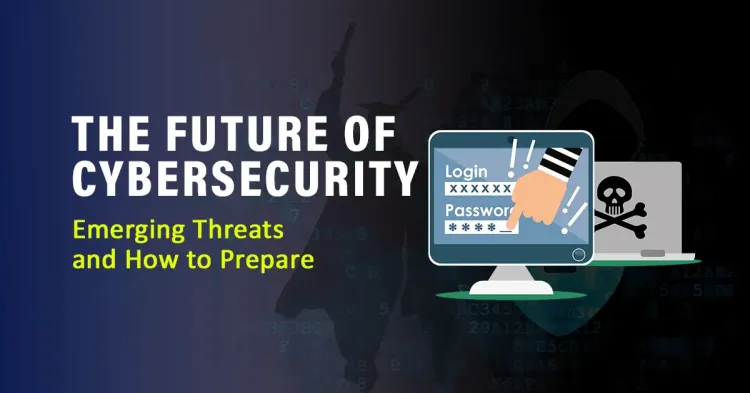The Future of Cybersecurity: Emerging Threats and How to Prepare
Explore the future of cybersecurity, including emerging threats like AI-powered attacks, ransomware evolution, and IoT vulnerabilities. Learn how to prepare with advanced security technologies, enhanced incident response plans, and strategies for emerging risks such as quantum computing and cyber warfare. Stay ahead of the curve with proactive measures and continuous learning.

As technology evolves, so do the threats facing organizations and individuals in the digital landscape. The future of cybersecurity is shaped by emerging threats that leverage advancements in technology, making it crucial for cybersecurity professionals and organizations to stay ahead of potential risks. This article explores anticipated trends in cybersecurity threats and provides strategies to prepare for and mitigate these risks effectively.
The Future of Cybersecurity: Key Trends and Considerations
The future of cybersecurity is shaped by rapid technological advancements and evolving threats. As we look ahead, several key trends and challenges are likely to define the cybersecurity landscape. Understanding these factors and preparing for them is crucial for safeguarding digital assets and maintaining robust security.
Emerging Threats
Artificial Intelligence (AI)-Powered Attacks:
AI is enhancing the capabilities of cybercriminals by enabling more sophisticated and automated attacks. AI can be used to create highly convincing phishing schemes, rapidly scan for vulnerabilities, and develop adaptive malware that changes its behavior to evade detection. These advancements make it crucial to adopt AI-driven security solutions to counteract these sophisticated threats.
- Trend: AI and machine learning are increasingly being used to enhance cybersecurity defenses, such as by improving threat detection and automating responses. However, these technologies also present new risks as cybercriminals use AI to create more sophisticated attacks.
- Consideration: Organizations should adopt AI-driven security solutions and stay informed about advancements in AI to effectively counteract emerging threats.
Quantum Computing:
Quantum computing poses a potential threat to current encryption methods. As quantum computers become more powerful, they may be able to break traditional encryption algorithms, which could compromise the security of sensitive data. Preparing for this involves investing in quantum-resistant encryption technologies and staying informed about advancements in quantum computing.
- Trend: Quantum computing promises to revolutionize computing power, which could potentially break current encryption methods. This poses a significant threat to data security.
- Consideration: Preparing for quantum computing involves investing in quantum-resistant encryption technologies and staying updated on developments in quantum computing.
Internet of Things (IoT) Vulnerabilities:
The proliferation of IoT devices introduces new security challenges, as many of these devices lack robust security features and are often targeted by attackers. To protect against IoT-related threats, it's important to implement network segmentation, enforce strong security policies for IoT devices, and regularly update firmware and software.
- Trend: The proliferation of Internet of Things (IoT) devices increases the number of potential entry points for attackers. Many IoT devices have inadequate security features, making them vulnerable.
- Consideration: Implementing strong security measures for IoT devices, such as network segmentation and regular updates, is essential to mitigate risks.
5G Network Risks:
The rollout of 5G technology brings increased speed and connectivity but also introduces new risks. The expanded attack surface and potential for increased data traffic may lead to new vulnerabilities. Ensuring 5G networks are secure involves using advanced security protocols, monitoring network traffic for anomalies, and working closely with network providers to address potential risks.
- Trend: The deployment of 5G technology enhances connectivity and speed but also introduces new security challenges. The increased data traffic and expanded attack surface can create new vulnerabilities.
- Consideration: Ensuring robust security for 5G networks involves using advanced security protocols, monitoring network traffic, and collaborating with network providers.
Ransomware Evolution:
Ransomware continues to evolve with new tactics such as double extortion (where attackers not only encrypt data but also steal and threaten to release it) and the use of ransomware-as-a-service (RaaS) platforms. Defending against these threats requires a combination of regular data backups, advanced security solutions, and employee training to recognize and respond to phishing attempts.
- Trend: Ransomware attacks are becoming more sophisticated, with tactics such as double extortion (encrypting and stealing data) and ransomware-as-a-service (RaaS) platforms.
- Consideration: Organizations should focus on regular data backups, advanced security solutions, and employee training to defend against evolving ransomware threats.
Supply Chain Attacks:
Attacks targeting third-party vendors or suppliers can have widespread impacts across multiple organizations. These attacks exploit the interconnectedness of systems to gain access to sensitive data. To mitigate this risk, organizations should conduct thorough due diligence on vendors, implement strong security practices throughout the supply chain, and monitor for unusual activities.
- Trend: Attacks targeting third-party vendors or suppliers are becoming more common. These attacks exploit the interconnectedness of systems to gain access to sensitive data.
- Consideration: Conducting thorough due diligence on vendors, implementing strong security practices throughout the supply chain, and monitoring for unusual activities are critical for prevention.
Increased Regulatory Requirements
- Trend: Governments and regulatory bodies are introducing stricter cybersecurity regulations to protect sensitive data and ensure compliance.
- Consideration: Organizations must stay informed about regulatory changes and ensure their security practices meet compliance requirements to avoid penalties and protect data.
How to Prepare
-
Invest in Advanced Security Technologies: Adopt security solutions that leverage AI and machine learning to detect and respond to emerging threats. These technologies can help identify patterns and anomalies that traditional methods may miss.
-
Develop a Comprehensive Security Strategy: Create a security strategy that includes regular updates to software and systems, strong access controls, and incident response plans. Ensure that your strategy addresses both current and anticipated threats.
-
Promote Cybersecurity Awareness: Conduct regular training sessions for employees to keep them informed about the latest threats and best practices for security. Awareness and vigilance are key to preventing attacks.
-
Implement Robust Encryption: Use strong, up-to-date encryption methods to protect sensitive data. Stay informed about advancements in encryption technology and prepare for potential quantum threats by exploring quantum-resistant options.
-
Monitor and Adapt: Continuously monitor your network and systems for signs of suspicious activity. Stay adaptable and be ready to update your security measures as new threats emerge.
-
Collaborate with Experts: Work with cybersecurity experts and organizations to stay informed about the latest developments in the field. Collaboration can provide valuable insights and resources for improving your security posture.
Conclusion
The future of cybersecurity will be shaped by the rapid evolution of technology and the increasing sophistication of cyber threats. By understanding emerging threats and proactively preparing through advanced security measures, continuous training, and robust response strategies, organizations and individuals can better protect themselves against the evolving landscape of cyber risks. Staying informed and adaptable will be key to maintaining resilience and security in an increasingly complex digital world.
FAQs
1.What are AI-powered attacks?
Answer: AI-powered attacks use artificial intelligence to enhance and automate cyber threats. This includes creating sophisticated phishing schemes, automating vulnerability scanning, generating adaptive malware, and producing deepfakes. AI enables attackers to execute more effective and complex attacks.
2.How is quantum computing affecting cybersecurity?
Answer: Quantum computing poses a threat to current encryption methods because it has the potential to break traditional encryption algorithms. This could compromise sensitive data security. Preparing involves exploring quantum-resistant encryption technologies and staying updated on quantum advancements.
3.What are IoT vulnerabilities and how can they be mitigated?
Answer: IoT vulnerabilities refer to security weaknesses in Internet of Things devices, which often lack robust security measures. To mitigate these vulnerabilities, organizations should implement network segmentation, enforce strong security policies, and regularly update device firmware and software.
4.What risks does 5G technology introduce?
Answer: The rollout of 5G technology introduces risks such as an expanded attack surface and increased data traffic that can lead to new vulnerabilities. Securing 5G networks involves using advanced security protocols, monitoring network traffic for anomalies, and working with network providers to address potential risks.
5.How is ransomware evolving?
Answer: Ransomware is evolving through methods like double extortion (encrypting data and stealing it), ransomware-as-a-service (RaaS), and data destruction. To defend against these threats, organizations should regularly back up data, use advanced security solutions, and train employees to recognize phishing attempts.
6.What are supply chain attacks and how can they be prevented?
Answer: Supply chain attacks target third-party vendors or suppliers to gain access to multiple organizations. Prevention involves conducting thorough due diligence on vendors, implementing strong security practices throughout the supply chain, and monitoring for unusual activities.
7.How can organizations prepare for emerging cybersecurity threats?
Answer: Organizations can prepare by investing in advanced security technologies, developing a comprehensive security strategy, promoting cybersecurity awareness, implementing robust encryption, monitoring for suspicious activities, and collaborating with cybersecurity experts.
8.What role does employee training play in cybersecurity defense?
Answer: Employee training is crucial for recognizing and responding to emerging threats, such as sophisticated phishing attacks and social engineering. Educating employees helps reduce the risk of successful attacks and strengthens the overall security posture.
9.Why is continuous monitoring important in cybersecurity?
Answer: Continuous monitoring helps detect and respond to threats in real-time, enabling early identification of unusual activities and potential breaches. It is essential for maintaining security and minimizing the impact of emerging threats.
10.What should an incident response plan include?
Answer: An incident response plan should include procedures for detecting, containing, and recovering from cyber incidents. It should also outline roles and responsibilities, communication strategies, and steps for mitigating damage and restoring normal operations.












![Top 10 Ethical Hackers in the World [2025]](https://www.webasha.com/blog/uploads/images/202408/image_100x75_66c2f983c207b.webp)



![[2025] Top 100+ VAPT Interview Questions and Answers](https://www.webasha.com/blog/uploads/images/image_100x75_6512b1e4b64f7.jpg)







